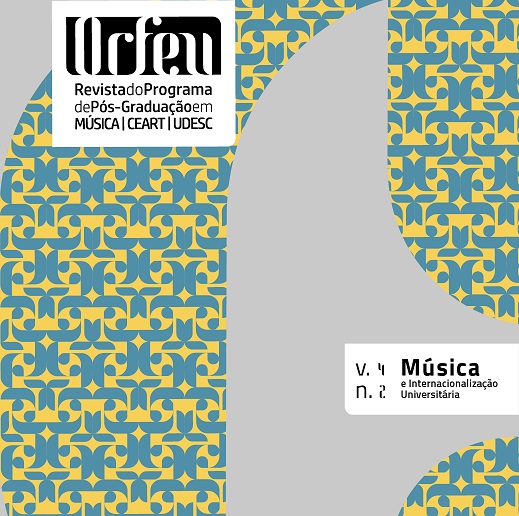Continuidade concreta: complicatio-explicatio-implicatio
DOI:
https://doi.org/10.5965/2525530404022019242Palabras clave:
Continuidade, Música contemporânea, Composição musical, Performance musicalResumen
Este artigo expõe a articulação entre três conceitos filosóficos como operadores da criação musical, tanto no âmbito da composição musical quanto da performance. Trata-se de uma retomada que o filósofo Gilles Deleuze faz dos conceitos de complicatio, explicatio e implicatio a partir de Giordano Bruno e outros filósofos que o antecederam. Partindo desse referencial, este trabalho apresenta de que maneira tais conceitos podem elucidar a questão da continuidade no discurso musical produzido recentemente, com ênfase no repertório brasileiro dos últimos dez anos. Dessa maneira, objetiva-se não apenas a condução de uma discussão conceitual, mas, principalmente, o vislumbre de soluções criativas para a música atual, contando, para tanto, com experiências dos próprios autores como exemplos de sua aplicabilidade.
Descargas
Citas
AGON, C.; BRESSON, J.; STROPPA, Marco. OMChroma, compositional control of sound synthesis. Computer Music Journal, Massachusetts: MIT, v. 35, n. 2, summer 2011.
BERGSON, Henri. Histoire de l'idée de temps, 1902-1903. Paris: PUF, 2017.
BERGSON, Henri. Essai sur les données immédiates de la conscience, Paris: PUF, 1927, p. 95.
BRUNO, Giordano. Cause, Principle and Unity. Trad. Robert de Lucca. Cambridge: Cambridge Univ. Press, 2004 [1584].
CATANZARO, Tatiana. Do descontentamento com a técnica serial à concepção da micropolifonia e da música de textura. In: CONGRESSO DA ASSOCIAÇÃO NACIONAL DE PESQUISA E PÓS-GRADUAÇÃO EM MÚSICA, 15., 2005, Rio de Janeiro. Anais […]. Rio de Janeiro: ANPPOM, 2005. p. 1246-1255.
DE CUES, Nicolas. La docte ignorance. Trad. Pierre Caye, David Larre, Pierre Magnard e Fréderic Vengeron. Paris: Flammarion, 2013 [1440].
DELEUZE. Gilles. Spinoza et le problème de l’expression. Paris: Minuit, 1968.
DELEUZE, Gilles. A dobra: Leibniz e o barroco. 6. ed. Trad. Luis Orlandi. Campinas: Papirus, 2012 [1988].
FERRAZ, Silvio. Análise e Percepção Textural: Peça VII, de 10 peças para Gyorgy Ligeti. Cadernos de Estudos: Análise musical, São Paulo: Através, n. 3, p. 68-79, 1990.
FERRAZ, S. Entretempo: a escuta no ponto cego da música. Viso Cadernos de estética aplicada, Ouro Preto: UFOP, n. 20, 2017.
GIL, José. Movimento total: o corpo e a dança. Lisboa: Relógio D’água, 2001.
GRISEY, Gérard. Écrits, 2008, p.31.
HERRAIZ, Martin. Um estranho perfeito: a música orquestral de Frank Zappa. Dissertação (Mestrado) – Instituto de Artes, Unesp, 2010.
HERVÉ, Nicolas; VENTURINI, Patrice; ALBE, Virginie. La construction du concept d’énergie en cours de physique: analyse d’une pratique ordinaire d’enseignement. In: BUTY, Christian; MORGE, Ludovic (ed.). Énergies, RDST: recherches en didactique des sciences et des technologies, n. 10/2014. Lyon, France, 2014. p. 123-151.
LIGETI, Gÿorgy. Neuf essais sur la musique. Genève: Contrechamps, 2001.
RIBEIRO, Guilherme; FERRAZ, Silvio. Guero: música concreta instrumental e direcionalidade na peça-estudo para piano de Helmut Lachenmann. Vórtex, Curitiba, v. 5, n. 1, p. 1-22, 2017.
SCHAEFFER, Pierre. Traitée des objets musicaux. Paris: PUF, 1966.
SIMURRA, Ivan Eiji; FERRAZ, Silvio. A utilização de técnicas apreendidas em estúdios como princípios composicionais em Atmosphères. In: CONGRESSO NACIONAL DE PESQUISA E PÓS-GRADUAÇÃO EM MÚSICA, 20., 2010, Florianópolis. Anais […]. Florianópolis: ANPPOM, 2010.
TAKEMITSU, Toru. Confronting Silence. Oxford: Scarecrow Press, 1995.
TARKOVSKI, Andrei. Die Versiegelte zeit. Berlim: Ullstein, 1986. (Tradução brasileira por Jefferson Camargo. São Paulo: Martins Fontes, 1998).
Descargas
Publicado
Cómo citar
Número
Sección
Licencia
Derechos de autor 2019 ORFEU

Esta obra está bajo una licencia internacional Creative Commons Atribución 4.0.






